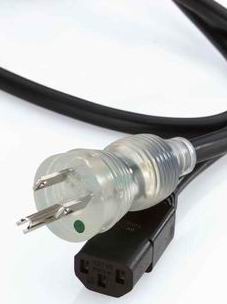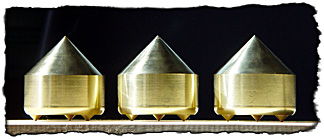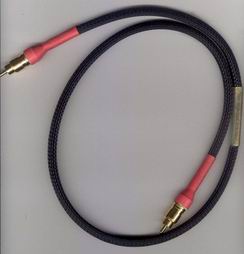Short Takes
| Short Takes |
|
Mini Reviews of Exciting New Products |
|
Henry Wilkenson |
|
25 July 2003 |
During the past year or so, I have come across several exciting new products that, in my opinion, deserve some special attention.
The Absolute Power Cord
 I have had a number of power cords in and out of my system and all of them did one thing or another to change the sonics of my reference system. Most power cords and interconnects for that matter, can be thought of as tuning devices or as tone controls. There is a vast world of cables out there and most of them have a definite sonic signature. After a listening session at Marshall Nack’s house, he gave me several power cords and asked me to give them a listen. (Good things happen, when you hang out with senior editors).
I have had a number of power cords in and out of my system and all of them did one thing or another to change the sonics of my reference system. Most power cords and interconnects for that matter, can be thought of as tuning devices or as tone controls. There is a vast world of cables out there and most of them have a definite sonic signature. After a listening session at Marshall Nack’s house, he gave me several power cords and asked me to give them a listen. (Good things happen, when you hang out with senior editors).
If you take a look at the Absolute Power Cords, their appearance may cause you to dismiss them right off. They are very plain and quite ordinary looking. But don’t let that fool you. Many of us have come to expect or even been conditioned to believe that aftermarket power cords should be large in diameter and perhaps “dressy” in appearance. With audio, as with other things, one should not judge the book, or in this case, the cable by its cover.
The Absolute Power Cords are manufactured in China by Cheng Chang for GTT Audio (www.gttgroup.com). Cheng Chang is based in Taiwan and is one of the largest OEM specialty power cord manufactures in the world. As I have already said, they are deceptively simple in appearance, however, they are constructed of high purity oxygen-free stranded copper. The conductors are soldered to the connectors rather than crimped or screwed in and the IEC and plug are hospital grade. This eliminates any chance of “microscopic electrical arcing”. In addition to all of this, these cords are UL approved as well! (You would be surprised at how much “high-end” gear is not UL approved. Your insurance company might be pleased about this fact.)
Sometime ago, Mike Silverton wrote a review of the Nordost cables for StereoTimes. Prefacing his description of the sound, he posed the question: “How do you describe the sound of nothing?” When I read his article, I was taken by that question. Now I find myself in the position of having to do just that, describe the sound of “nothing.” I wired my system with the Absolute Power Cords, gave them an adequate burn in period, and then set about describing how they sounded.
I decided that the best way to describe these cords is in terms of what they do not do. Will they extend the range of your system to reveal the bottom octave that you were unaware of? Well, in a word, no. Will they give you a midrange and top end to die for? I don’t think so. Will they stomp the competition, kick everything else to the curb, and reveal music to you as never before, while requiring you to develop a new way of listening to explain what you are hearing? No, not at all. What these cables will do is deliver unadulterated power to your system. Simply stated, they do not emphasize any area of the audio spectrum nor do they bring any other artifacts to the listening experience either. If you are looking for the oft written about sonic neutrality, here it is. These power cords can benefit you in at least two ways. First they will allow you to hear your components straight up and on their own, save for which ever interconnects you happen to be using. Secondly, it will allow you to voice your system by tuning individual components with high priced power cords as needed, if at all.
I’ve deliberately saved the best part for last. These cables will set you back all of $59.95 each retail. If you order on line, they are only $49.95!!! One could outfit an entire system for half the cost of just one of some of the really high priced power cords that are so common these days. Pay a visit to the GTT web site and see the company the Absolute power cords are keeping these days. While these cords are priced at or below what you would expect to pay for entry-level accessories, they by no means render entry-level performance.
I have often read about gear with price tags that resemble serial numbers, referred to as sonic bargains. If there was ever a sonic bargain, this is it by far. Neutral sonics, UL approved, and ridiculously low prices, what more could you ask for.
Mapleshade Ultimate Triplepoints
Pierre Sprey, President of Mapleshade and Wildchild recording studios, founded the studios after a long and very distinguished career as an aerospace engineer. From the company’s beginning in 1986, Mapleshade has produced reference quality jazz and blues CD’s based on analogue tape masters. What sets Mapleshade recordings apart from the rest is their decidedly analogue sound. I have several friends that only knew digital recordings, and were mightily impressed by the sonics of a Mapleshade CD. The company has broadened its scope and now produces several lines of cables, interconnects, speaker stands, audio stands, (review to soon follow) and the subjects of this review, the Ultimate Triplepoints brass coupling devices. All of their products are available on their website (http://www.mapleshaderecords.com/).

If you’ll notice, I called the Ultimate Triplepoints, “coupling devices” and not isolation devices. Over the course of several conversations with Pierre, he clearly made the point that there is a major difference between the two kinds of devices. As opposed to suspending a component to provide isolation from any ambient vibrations, The Ultimate Triplepoints (UTP), are designed to drain internally generated vibrations out of the component. This is accomplished by providing a vibration-draining path to the shelf the equipment is sitting upon. The UTPs effectively couple the component to the shelf, and depending on the shelf, will allow vibrations to be channeled to the floor. Mapleshade replaces the normal cones flat top with three points. This eliminates the “micro-rattles” that occur between the flat top of a normal cone and a not perfectly flat bottom of the component.
These cones are 2½” tall by about 2″ in diameter and come in sets of three. My guess is that they weigh between two and three pounds each and are made of solid brass. The point on the bottom as well as the three on the top are very sharp, so please do yourself a favor and exercise care while handling them.
I installed the UTPs under my power and pre amps as well as my DAC. These cones are not that simple to install unless you know the trick. If you try to insert the cones point side down, more than likely you will get maybe two in and when you insert the third one, the other two will fall over. I couldn’t get the cones in until I spoke to a gentleman named Eldon at Mapleshade who suggested a solution. Install the UTPs up side down at first. Once you have them placed where you want them under your component, and then turn them over one at a time. Voila’, it worked. Once you have them installed, gently try to rock the component. If you can move or rock the component, gently adjust them one at a time until the component that you are installing them under sits solidly on all three of the points.
Of all of the coupling/isolation devices that I have used to date, these were the most difficult to install; at the same time, they were the most effective. One sonic change that I noticed immediately was an increase in image focus from top to bottom. This was accompanied by a smaller but audible increase in midrange clarity. The UTPs made the largest impact in the bass. The bass tightened to the extent that it could be misperceived as a reduction of bass. The fact is the extension was still there, but, minus any excess bloat or excessive resonance.
At the end of the day, the Ultimate Triplepoints made a major improvement in the sound of my system. At $110.00 per set, the decision to keep them in the system was an easy one to make.
Mystery Digital Cable
 As you know, with interconnects and speaker cables, the price and performance spread between the top-of-the-line and the bottom has never been greater than it is today. With some of the top wire costing in the thousands of dollars, it is comforting to know that there are still cables available that offer very good performance at entry-level prices.
As you know, with interconnects and speaker cables, the price and performance spread between the top-of-the-line and the bottom has never been greater than it is today. With some of the top wire costing in the thousands of dollars, it is comforting to know that there are still cables available that offer very good performance at entry-level prices.
Audio Insurgents is a small company headquartered in New York that has come up with a digital cable that is creating a buzz in local audiophile circles. The word is that this is a very good sounding cable and is available from Music Direct for $79.00 per meter. According to the manufacturer, Mystery digital cable is constructed with several shields surrounding a balanced construction of many strands of high purity copper. This configuration is said to result in very low noise and a very wide bandwidth while avoiding the drawbacks of this type of design.
The cable is directional and should be installed with the gold label end at the transport. While this is the recommended installation, it is by no means an absolute. I would advise that you burn the cable in this way and change the orientation later to determine which way sounds best to you.
I finally managed to get a review sample and gave it an extended listen. Sonically, the Mystery Cable falls somewhat on the warm side of the spectrum. Low-end extension is good but lacks the control and detail of the much higher priced competition.
Imaging was good from left to right across the stage; it never exceeded the width of the speakers. The center image was stable with performers placed to the left and right of center where appropriate. Depth was somewhat foreshortened, but I would expect that in a cable at this price point.
The treble was noticeably diminished as well as the extreme highs. Cymbals sounded somewhat recessed and didn’t have the detail that other much higher priced cables are capable of rendering. This can be a very good thing because the gear that the Mystery Cable is likely to be paired with tends to be much too bright in these regions. In that case, you could end up with a perfect pairing here. You must understand that the areas where the Mystery cable falls short, such as treble extension, detail and imaging, became apparent only in direct comparison to the far more expensive (12½ times more expensive), Von Gaylord digital cable.
The Audio Insurgents Mystery digital cable is not an attempt to take the high-end market by storm. Rather, this is an attempt to offer a very good entry-level cable that is very reasonably priced. As all audiophiles know, you can always spend more but not necessarily realize better performance. In their endeavor to offer a product that has real value, I believe that Audio Insurgents has been successful.
![]()
Don’t forget to bookmark us! (CTRL-SHFT-D)
Stereo Times Masthead
Publisher/Founder
Clement Perry
Editor
Dave Thomas
Senior Editors
Frank Alles, Mike Girardi, Key Kim, Russell Lichter, Terry London, Moreno Mitchell, Paul Szabady, Bill Wells, Mike Wright, Stephen Yan, and Rob Dockery
Current Contributors
David Abramson, Tim Barrall, Dave Allison, Ron Cook, Lewis Dardick, Dan Secula, Don Shaulis, Greg Simmons, Eric Teh, Greg Voth, Richard Willie, Ed Van Winkle, and Rob Dockery
Music Reviewers:
Carlos Sanchez, John Jonczyk, John Sprung and Russell Lichter
Site Management Clement Perry
Ad Designer: Martin Perry





Be the first to comment on: Short Takes